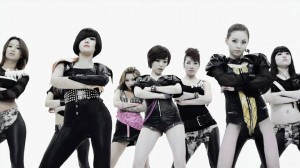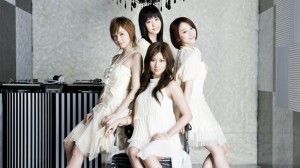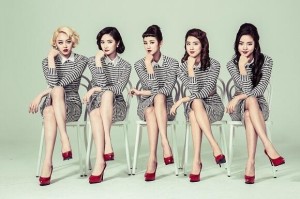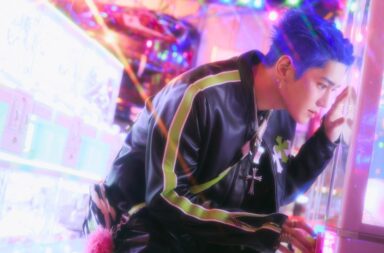It’s safe to say that K-pop is about 75% visual. In an industry that relies heavily on appearances, it’s no surprise that newer, younger models continue to crop up. It’s also unsurprising that most of those groups aren’t exactly selling vocal excellence.
Then SoReal debuted. The pretty boy quartet dropped a teaser of their mini-album, So Real Story. It was very reminiscent of some of the vocal groups of old in K-pop. While it and their subsequent debut single and music video, titled “My Heart Says,” are filled mostly with the same pop fare that most groups display, Star Empire’s rookie group sports some surprisingly competent and powerful harmonization, the likes of which hasn’t been really seen in groups as of late.
[youtube http://www.youtube.com/watch?v=p6KecRHg130]
This concept of a group in which each member has a strong voice and is therefore tackling more technically complex material isn’t exactly an alien concept in K-pop. In fact, looking back at K-pop’s first and second generations, it’s easy to see a slew of groups found at least midlevel success with this concept.
Big Mama was a group apart, debuting females that didn’t fit an industry standard of beauty — they were thicker, varied in age, had normal faces, and weren’t concerned with attempting the aegyo or sexy concepts their more popular peers found great commercial success with. Each member had a voice that could put many Western R&B and Soul singers to shame, and that translated into having tight harmonies and releasing decidedly more mature music.
As a part of YG’s sister label M Boat, the group enjoyed a decent amount of success. Their debut album, 2003’s Like The Bible, sold over 100,000 copies, and their sophomore effort, 2005’s It’s Unique, enjoyed even greater critical success. That same year they were invited to perform with Boyz II Men. The concert, titled “The Real Harmony: Big Mama & Boyz II Men Joint Concert,” was a huge enterprise, YG spending one billion won (about $950,000 USD) on a professional stage crew from Japan.
However, inevitability set in, and the women of Big Mama slimmed down to fit more “traditional” industry standards. The group eventually left YG in 2007 because of lack of promotion and released album Blossom under label Manwalldang. The album enjoyed decent success, selling 60,000 copies. But after eight years the group officially disbanded.
[youtube http://youtu.be/Dl5n7-nO-WI]The Piggy Dolls also enjoyed some success. Taking a page from Big Mama’s book, the ladies debuted as rebuttal to an industry more partial to girl groups featuring slim members with varying levels of vocal skill. They were all thick, voluptuous women with unbelievably strong voices. Their “gimmick,” such that it was, was more overt than their predecessors in Big Mama, at times tending to outshine the actual talent of each singer.
[youtube http://youtu.be/wuSbkmLpxic]In the end, however, the name of the game is profit, and much like Big Mama before them, the girls slimmed down, Winning InSight Entertainment preferring to scrap their original concept in lieu of gaining more tangible popularity. When the Piggy Dolls made their second comeback after a six-month absence, fans were treated to an entirely new lineup of young ladies who better prescribed to the standard of Korean beauty.
However, the vocals were typical K-pop fare. While there’s nothing wrong with that in the grander scope of K-pop, it belies what the original lineup represented—standing essentially on vocals without the “looks” to fall back on. And the results are clear: going by YouTube views alone, the original Piggy Dolls received, at best, just over 1200 views for their official MV for single “Trend;” the new lineup garnered over 66,000 views for their single “Ordinary Girl” and over 110,000 views for their video for “Butterflies.”
 Brown Eyed Girls is a rarity in K-pop, a self-composed group that managed to be successful on the merits of their voices. Leader Jea hand-picked Miryo, a known presence in the hip-hop community, and Narsha, someone she remembered from high school. The three of them selected Ga-in after the magnae was found crying in a restroom after being eliminated from Battle Shinhwa.
Brown Eyed Girls is a rarity in K-pop, a self-composed group that managed to be successful on the merits of their voices. Leader Jea hand-picked Miryo, a known presence in the hip-hop community, and Narsha, someone she remembered from high school. The three of them selected Ga-in after the magnae was found crying in a restroom after being eliminated from Battle Shinhwa.
Initially they were another group based purely on vocal strength, releasing more R&B-heavy tracks and remaining faceless for much of the early part of their career. They enjoyed a great deal of critical success but didn’t quite reach the commercial recognition they coveted. However, a recurring trend with at least the female vocal groups prevailed: the group had changed their concept and packaging, cashing in on their looks and feminine sensuality.
With their third album Sound G, they released track “Abracadabra,” a completely different style and concept to their previous R&B and ballad inclinations. Gone were the days of the “faceless” vocalists. This music video highlighted their aesthetic appeal and introduced the sensual “hip dance” that has become a K-pop choreography mainstay.
When it comes to the guys, it’s much of the same. Groups like Brown Eyed Soul, while maintaining a steady following, will never truly garner the success of their idol peers. History has shown that strictly R&B and Soul concepts in South Korea aren’t exactly selling points, especially if there isn’t a blatantly visual aspect to the group’s makeup.
Group 2AM, while enjoying some of the fruits of that coveted mainstream popularity, still stands somewhat in the shadow of their dance/pop brothers 2PM. Initially part of an eleven-member unit known as One Day, the group was split in two—one unit to handle the more pop-heavy side, while the other would belt out the ballads. 2AM’s vocals take center stage, which leaves their visibility more subtle. Again, the vocal subunit is blessed with a loyal following, but much of that popularity is thanks to the individual members’ activities, most notably Jo Kwon, whose flamboyant persona has arguably had the biggest hand in boosting the group’s visibility.
[youtube http://youtu.be/HWgH0DsD0pQ]Still, 2AM wasn’t above or without the need to flash a little flesh to get some due recognition. Men are just as susceptible to the whims of an industry whose priority is visual appeal above all else. As a part of a genre that’s heavily saturated with pretty boys with godlike bodies, having vocal talent falls to the background as a consequence of an accepted and renowned rule of thumb in the entertainment industry: sex sells. Even the most gorgeous voices have to get a little sexy to make their presence viable.
It almost makes one wonder exactly how DBSK actually succeeded on the scale that they did. What Lee Soo-man managed to create with these five lads was truly a once in a lifetime phenomenon. The first member of the then nebulous quintet was Junsu, a kid with an incredibly unique voice, but whom they apparently didn’t know what to do with until his voice cracked (he became a trainee with SM at the age of eleven). Yunho and Jaejoong were part of their own experimental group at SM with Super Junior’s Heechul and Kangin called Four Seasons. The company struck gold once again with the arrival of a young kid with an unreal vocal range (Changmin), and then again with a kid with a smokier voice and piano skills coming off a stint in the US (Yoochun). Somehow, someone at SM had the brilliant idea to put these five young chaps in the same group.
This was truly the luckiest of the draws. SM set out to create the second coming of H.O.T; what they got was one of the most impressive (and undeniably most successful) vocal groups in K-pop history. Most of their concepts were relatively tame, even at times questionably goofy. And while the concept of their Korean comeback in 2008 was blatantly sexy—arguably the most successful K-pop album of all time, Mirotic—they’d been in the industry for five years and had more than established the focus of their group concept as good music and big vocals. Though DBSK didn’t begin with the goal of being a full-out vocal group, after their first album it was clear their a cappella performances and impeccably razor-sharp harmonization would separate them from the K-pop groups at that time.
[youtube http://youtu.be/yQGbIrGLIK0] With DBSK’s unconscionable success, SM sought to create the female equivalent, no doubt hoping to cash in on the innate feminine charms of the group while still maintaining their vocal integrity. CSJH The Grace had their own brush with success, their debut (and only Korean release) One More Time, Okay? topped both the M! Countdown and Inkigayo charts and reached as high as number six the month of its release.
With DBSK’s unconscionable success, SM sought to create the female equivalent, no doubt hoping to cash in on the innate feminine charms of the group while still maintaining their vocal integrity. CSJH The Grace had their own brush with success, their debut (and only Korean release) One More Time, Okay? topped both the M! Countdown and Inkigayo charts and reached as high as number six the month of its release.
Unfortunately, despite all the best intentions, The Grace never took off with any success on the scale of their male counterparts. There could be a slew of reasons why the group just didn’t take. But in the end, SM put more of their power behind super-group SNSD. They’re a large group of beautiful females, attitude and sass overload. While they were never intended to be a vocal group, their overall concept and style overshadow the vocal talent of a few of their members, those with the stronger voices showcasing them in solo stages and side projects. Inevitably, The Grace sort of whimpered out of relevance, even with the debut of the Dana and Sunday subunit after a four-year silence.
With groups like SuPearls—another YG construct that included a visually diverse cast of vocalists, including a noticeably absent Lee Hi and former YG recruit and recent debut artist Lee Michelle—coming and going with mostly zero fanfare or promotion, it’s not hard to discern the actuality of K-pop’s scope: vocals aren’t the focus, more visual impact and instant gratification.
However, as with every rule, there are those exceptions. Spica, an all-girl outfit under B2M Entertainment that’s made a splash with their mature vocals and very distinct visual style, has managed to find that balance between aesthetic appeal and explosive vocal talent among each member. Just like DBSK before them, they haven’t had to sacrifice one aspect of their appeal for another. Along with their vocal ability, they’ve also managed to step outside of the box concept-wise, everything from lovable hippies in their video for “Tonight,” to their tribute to the Andrew Sisters in their latest MV for “You Don’t Love Me.” The obvious beauty of their members may in fact be the reason why they’ve been afforded this fluidity in group identity.
 The message is strikingly clear. In order for the female groups to at least enjoy a fraction of the success of most groups in the industry, they have to slim down and sexy up, pushing their vocal focus aside to appeal to the prevailing aesthetic, and the guy groups can’t rely on their voices alone to propel them into any sort of incredible notoriety, seemingly fading into the background with every other group or being content with underground success.
The message is strikingly clear. In order for the female groups to at least enjoy a fraction of the success of most groups in the industry, they have to slim down and sexy up, pushing their vocal focus aside to appeal to the prevailing aesthetic, and the guy groups can’t rely on their voices alone to propel them into any sort of incredible notoriety, seemingly fading into the background with every other group or being content with underground success.
It’s hard to fault the industry for something that’s proven lucrative since the beginning of pop music. As long as teenagers inhabit the earth, there will be pretty boys and girls to entice them and record companies to cash in on the raging hormones. But for the grown folks, there’s a little bit more at stake, a little more that we need to take away from anything we listen to. The vocal groups that have come and gone have proven that not every group will rely on its superficial charm to garner attention. Perhaps the presence of Spica and now SoReal signals a “return to center,” a chance for K-pop to go back to a time when the music was just as important as the image.
(MTVK, YouTube[1], [2],[3], [4], [5], Generasia, CASA[original article from the Korea Herald no longer available], Seoulist Mag, Naver, B2M Entertainment)


